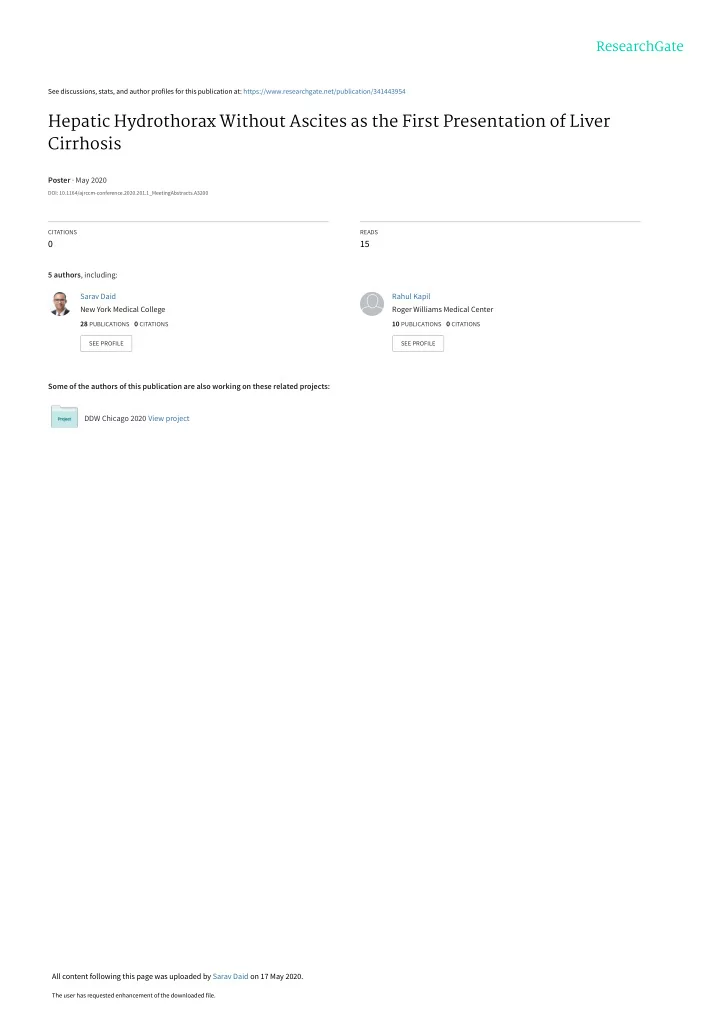

See discussions, stats, and author profiles for this publication at: https://www.researchgate.net/publication/341443954 Hepatic Hydrothorax Without Ascites as the First Presentation of Liver Cirrhosis Poster · May 2020 DOI: 10.1164/ajrccm-conference.2020.201.1_MeetingAbstracts.A3200 CITATIONS READS 0 15 5 authors , including: Sarav Daid Rahul Kapil New York Medical College Roger Williams Medical Center 28 PUBLICATIONS 0 CITATIONS 10 PUBLICATIONS 0 CITATIONS SEE PROFILE SEE PROFILE Some of the authors of this publication are also working on these related projects: DDW Chicago 2020 View project All content following this page was uploaded by Sarav Daid on 17 May 2020. The user has requested enhancement of the downloaded file.
B38 CASE REPORTS IN DYSPNEA AND IMMUNODEFICIENCY / Thematic Poster Session Hepatic Hydrothorax Without Ascites as the First Presentation of Liver Cirrhosis R. Kapil 1 , D. Guadarrama 2 , C. Hiraldo-Infante 1 , S. Daid 1 , J. V. Meharg 3 ; 1 Internal medicine, Roger Williams Medical Center, Providence, RI, United States, 2 Pulmonary Medicine, Roger Williams Medical Center, providence, RI, United States, 3 Roger Williams Medical Ctr, Providence, RI, United States. Corresponding author's email: rahul.om.kapil@gmail.com Introduction Hepatic hydrothorax(HH) is defined as a significant pleural effusion (>500ml) in patients with liver disease. Very rarely, it can present as the first sign of liver disease, without the presence of ascites. Here we report a case of hepatic hydrothorax in a 57 year old female who presented with shortness of breath, without ascites or known liver disease. Case A 57 year old female with past medical history of HIV, alcohol dependence and rheumatoid arthritis presented to the hospital complaining of progressively worsening shortness of breath. Associated with weight loss and nonproductive cough. Per records, 1.4L of transudative pleural fluid was removed one week prior to presentation.Vitals were stable on admission. Physical exam demonstrated right hemithorax, and normal heart sounds. Abdomen was soft, non distended, no fluid thrill or flank dullness were noted. Lab was significant for leukocytosis, thrombocytopenia, elevated INR, hyponatremia, indirect hyperbilirubinemia. Chest imaging revealed a large right-sided pleural effusion with mass effect on the mediastinum and trachea. CT abdomen was consistent with liver cirrhosis, splenomegaly, GE junction varices, and mild abdominal ascites. Thoracentesis removed 1.1 L of transudative fluid. Echocardiogram showed an ejection fraction of 65% and an extracardiac shunt, diagnosed with hepatopulmonary syndrome. She was started on low sodium diet, fluid restriction, diuretics, beta blocker. Recent alcohol intake and MELD score of 20, disqualified her for TIPS or liver transplant. Pleurodesis was discussed, but she refused. Over two months, she developed multiple effusions, complications from hepatorenal syndrome, pneumonia and fulminant sepsis. Unfortunately, she did not get better and passed. Discussion HH as the first presentation of liver disease is rare and can be diagnostically challenging. Most accepted mechanism is the direct passage of peritoneal fluid through the diaphragmatic defects. Studies have shown the passage of dye through these defects. Huang et al, performed a study that visualized and graded these defects. Fluid movement is aided by positive abdominal pressure and negative pleural pressure during inspiration. HH is usually diagnosed clinically, but pleural studies, echocardiogram, and renal studies should be performed to rule out other causes. Additionally, injection of radioisotope material can be performed to visualize the movement of fluid into the pleural cavity. Medical management includes sodium and fluid restriction, and diuretics. Serial thoracentesis can be performed. Pleurodesis, TIPS and liver transplant have proven to be effective in some candidates.
This abstract is funded by: none Am J Respir Crit Care Med 2020;201:A3200 Internet address: www.atsjournals.org Online Abstracts Issue View publication stats View publication stats
Recommend
More recommend